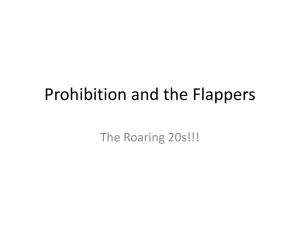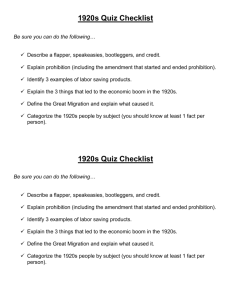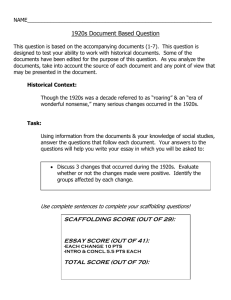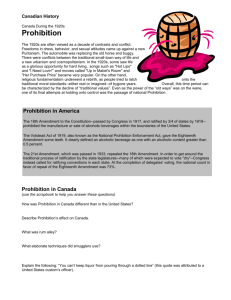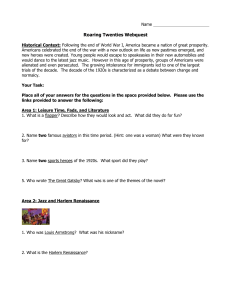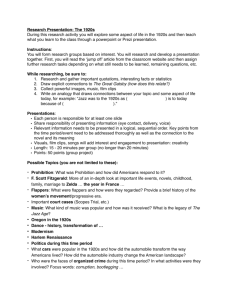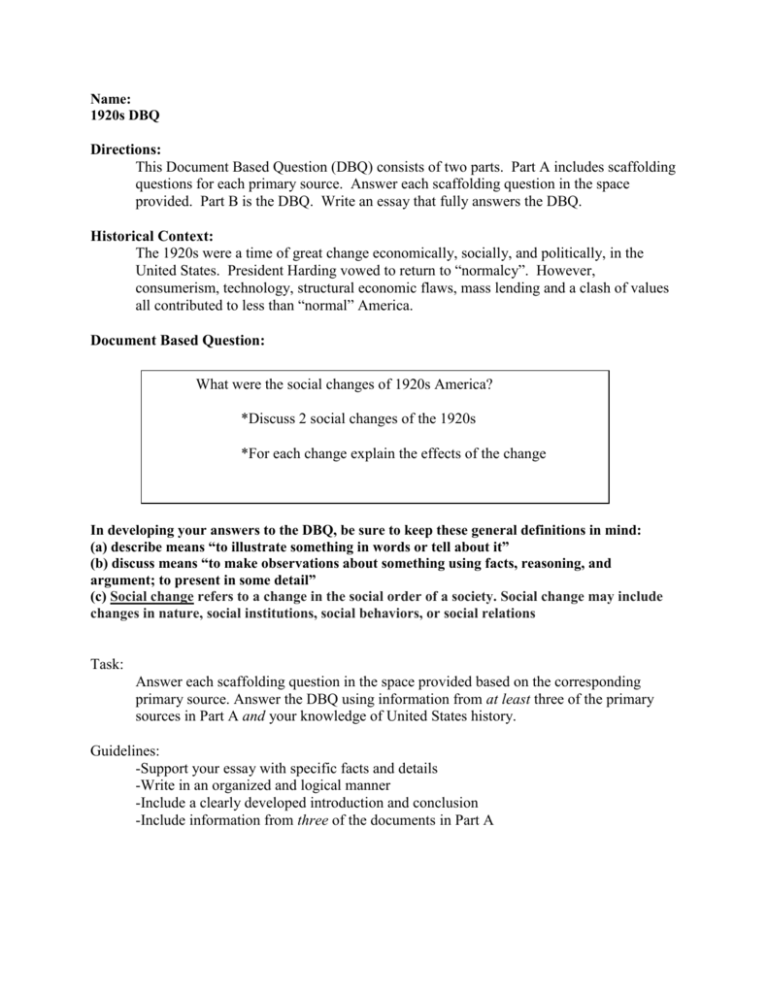
Name:
1920s DBQ
Directions:
This Document Based Question (DBQ) consists of two parts. Part A includes scaffolding
questions for each primary source. Answer each scaffolding question in the space
provided. Part B is the DBQ. Write an essay that fully answers the DBQ.
Historical Context:
The 1920s were a time of great change economically, socially, and politically, in the
United States. President Harding vowed to return to “normalcy”. However,
consumerism, technology, structural economic flaws, mass lending and a clash of values
all contributed to less than “normal” America.
Document Based Question:
What were the social changes of 1920s America?
*Discuss 2 social changes of the 1920s
*For each change explain the effects of the change
In developing your answers to the DBQ, be sure to keep these general definitions in mind:
(a) describe means “to illustrate something in words or tell about it”
(b) discuss means “to make observations about something using facts, reasoning, and
argument; to present in some detail”
(c) Social change refers to a change in the social order of a society. Social change may include
changes in nature, social institutions, social behaviors, or social relations
Task:
Answer each scaffolding question in the space provided based on the corresponding
primary source. Answer the DBQ using information from at least three of the primary
sources in Part A and your knowledge of United States history.
Guidelines:
-Support your essay with specific facts and details
-Write in an organized and logical manner
-Include a clearly developed introduction and conclusion
-Include information from three of the documents in Part A
Document 1
1. Who are Sacco & Vanzetti? [2]
_________________________________________________________________________________
_________________________________________________________________________________
_________________________________________________________________________________
_________________________________________________________________________________
2. What is the creator of this poster advertising? Why? [2]
_________________________________________________________________________________
_________________________________________________________________________________
_________________________________________________________________________________
_________________________________________________________________________________
Document 2
Immigration to the United States
1921
140,000
Northwestern Europeans
1926
70,000
180,000
Central Europeans
50,000
40,000
Eastern Europeans
5,000
295,000
Southern Europeans
10,000
20,000
Asians
2,000
Make a generalization about how immigration changed from 1921 – 1926?
______________________________________________________________________________
______________________________________________________________________________
______________________________________________________________________________
______________________________________________________________________________
Document 3: Text taken from Prohibition History
At midnight, January 16, 1920, the United States went dry. Breweries,
distilleries, and saloons were forced to close their doors.
Led by the Anti-Saloon League and the Women's Christian Temperance Union, the dry
forces had triumphed by linking Prohibition to a variety of Progressive era social causes.
Proponents of Prohibition included many women reformers who were concerned about
alcohol's link to wife beating and child abuse and industrialists such as Henry Ford who
were concerned about the impact of drinking on labor productivity. Advocates of
Prohibition argued that outlawing drinking would eliminate corruption, end machine
politics, and help Americanize immigrants.
The noble experiment ended at 3:32 p.m., December 5, 1933, when Utah became
the 36th state to ratify the 21st Amendment, repealing Prohibition. By then, even
some proponents admitted that the 18th Amendment resulted in "evil
consequences." The Rev. Sam Small, an evangelist and temperance advocate said
that Prohibition had created "an orgy of lawlessness and official corruption." John
D. Rockefeller, a teetotaler, observed in 1932, "drinking has generally increased,
the speakeasy has replaced the saloon; a vast army of lawbreakers has been
recruited and financed on a colossal scale."
1. According to the document, who are 2 groups who fought for Prohibition? [2]
_________________________________________________________________________________
_________________________________________________________________________________
2. According to the document, what was the benefit of Prohibition? [1]
_________________________________________________________________________________
_________________________________________________________________________________
3. According to the document, was Prohibition successful? Why / why not? [2]
_________________________________________________________________________________
_________________________________________________________________________________
_________________________________________________________________________________
Document 4-Speakeasies and Bootlegging
1. From the 2 photos above, what can you infer about the availability of alcohol during
Prohibition? [2]
________________________________________________________________________
________________________________________________________________________
________________________________________________________________________
Document 5: Political Changes for Women
In 1920, after 72 years of struggle, American women received the right to vote. After the
19th Amendment passed, reformers talked about female voters uniting to clean up
politics, improve society, and end discrimination.
At first, male politicians moved aggressively to court the women's vote, passing legislation
guaranteeing women's right to serve on juries and hold public office. Congress also
passed legislation to set up a national system of women's and infant's health care clinics
as well as a constitutional amendment prohibiting child labor, a measure supported by
many women's groups.
But the early momentum quickly dissipated, as the women's movement divided
within and faced growing hostility from without. The major issue that split feminists
during the 1920s was a proposed Equal Rights Amendment to the Constitution
outlawing discrimination based on sex. The issue pitted the interests of professional
women against those of working class women, many of whom feared that the
amendment would prohibit "protective legislation" that stipulated minimum wages
and maximum hours for female workers.
1. Other than the right to vote, according to the document, name 2 positive changes made for
women in the 1920s. [2]
_______________________________________________________________________________
_______________________________________________________________________________
2.
According to the document, what issue did many women not agree on? [1]
_________________________________________________________________________________
_________________________________________________________________________________
Document 6
1890s
1920s
1. Describe 2 differences between the women of the Victorian era and the flappers of the 1920s. [2]
______________________________________________________________________________
______________________________________________________________________________
_________________________________________________________________________________
_________________________________________________________________________________
Document 7
I, Too, Sing America
by Langston Hughes
I, too, sing America.
I am the darker brother.
They send me to eat in the kitchen
When company comes,
But I laugh,
And eat well,
And grow strong.
Tomorrow,
I'll be at the table
When company comes.
Nobody'll dare
Say to me,
"Eat in the kitchen,"
Then.
Besides,
They'll see how beautiful I am
And be ashamed-I, too, am America.
From The Collected Poems of Langston Hughes, published by Knopf and Vintage Books. Copyright © 1994 by the Estate of Langston Hughes. All rights reserved. Used by
permission of Harold Ober Associates Incorporated. Harlem Renaissance.
1. Who is the author of the above poem? [1]
___________________________________________________________________________
___________________________________________________________________________
2. What specific period of the 1920s was this poem written? [1]
___________________________________________________________________________
___________________________________________________________________________
Document 8a
Document 8b
I am fed up
With Jim Crow laws,
People who are cruel
And afraid,
Who lynch and run,
Who are scared of me
And me of them.
I pick up my life
And take it away
On a one-way ticket
Gone Up North
Gone Out West
Gone!
-Langston Hughes1926
1. What region of the U.S. is the author fed up with? [1]
_________________________________________________________________________________
2. In this document, the author states that he has “Gone” because of what reason? [1]
______________________________________________________________________________
______________________________________________________________________________
______________________________________________________________________________
3.What do historians refer to this movement as? [1]
______________________________________________________________________________
______________________________________________________________________________


